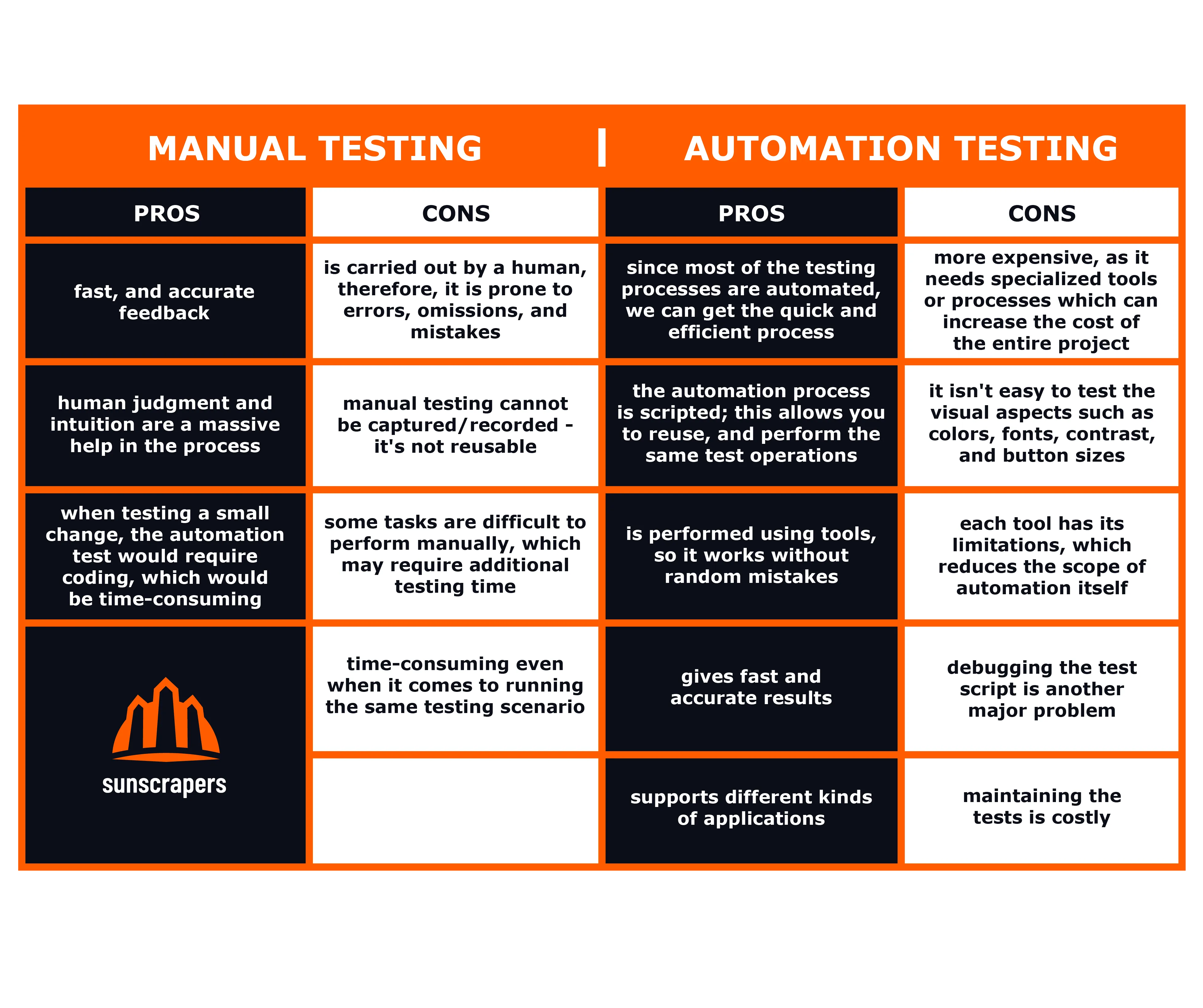
Sunscrapers Team
29 August 2022, 4 min read

What's inside
Intro
At the beginning of each project, we face a dilemma about what testing approach to choose - manual or automation. Both have their strengths and weaknesses, so how to decide between them?
What's the difference?
What exactly is the difference between manual and automatic tests?
Manual testing is exploration. It requires taking a broad and not always formal look at the product. Its goal is to find as many errors as possible and ask questions - "is it supposed to work this way?". Analysts and QA engineers are involved in everything from test case creation to actual test execution. Manual testers perform the tests without test scripts and often don't need knowledge of programming languages or additional tools.
Automated testing is validation - making sure the product works as required. The purpose of automated testing is not to find errors but the opposite - to show the product doesn't have bugs in critical scenarios. The automation tester needs to know the programming language and framework he'll use to write and perform tests. Therefore, he does not check the application each time manually but writes commands that the additional tool carries out for him.
Manual testing
Pros:
- fast and accurate feedback
- human judgment and intuition are a massive help in the process
- when testing a small change, the automation test would require coding, which would be time consuming
Cons:
- is carried out by a human, therefore is prone to errors, omissions, and mistakes
- manual testing cannot be captured/recorded - it's not reusable
- some tasks are difficult to perform manually, which may require additional testing time
- time-consuming even when it comes to running the same testing scenario
Manual testing is the exploration process focused on looking for strange responses from the tested product. Its informality and uniqueness become an advantage that guarantees more excellent coverage with each performance of the same scenario. Exploration is aimed at improving the product quality and is less focused on finding critical bugs - and more on looking for improvements and striving for consistency. Paradoxically, the exploration statistically finds six times more errors in the product than automation (assuming that the human was given the same scenario as the machine to execute).
Pros of the manual testing end where repeatability and human errors begin. Some scenarios are not complex but need to be repeated many times - one mistake, and you have to start over. This can take a lot of time and is not necessarily pleasant for a tester, and that can cause more mistakes. This is the time when test automation should be considered seriously.
Another case is regression testing before every product release. Depending on release frequency, it will take hours or even days to check if the product meets all the requirements. You may not have changed anything in the older features, but it still needs to be confirmed that the new ones didn't affect them.
Automated tests
Pros:
- since most of the testing process is automated, we can get a quick and efficient process
- the automation process is scripted; this allows you to reuse and perform the same test operations
- is performed using tools, so it works without random mistakes
- gives fast and accurate results
- supports different kinds of applications
Cons:
- more expensive, as it needs specialized tools or processes which can increase the cost of the entire project
- it isn't easy to test the visual aspects such as colors, fonts, contrast, and button sizes
- each tool has its limitations, which reduces the scope of automation itself
- debugging the test script is another major problem
- maintaining the tests is costly
Automated tests are perfect for CI/CD and checking whether the product is error-free on critical functionalities, scenarios, and API. In addition, well-designed automation provides reliable feedback containing information such as configuration, logs, and the place in the code that generated the error.
However, validation is limited to defined scenarios. It focuses on critical paths, and budget constraints make test coverage low. Theoretically, the product is tested and works, but any edge cases in the tested scenario will generate an error. Validation is, therefore, a process that answers the question of whether the quality of a product meets the minimum requirements - but it won't precisely show its actual quality and what needs improvement. Validation is not intended to enhance the quality of the product but to detect its decline.
These tests are costly, and introducing them too quickly to an immature product will mean that test developers will spend more time updating them than writing new ones.

Summary
There are no perfect projects and complete requirements - each project requires clarification before proceeding to the next development phase. Therefore, the optimal process is to combine manual tests and automation, using the advantages of both approaches.


